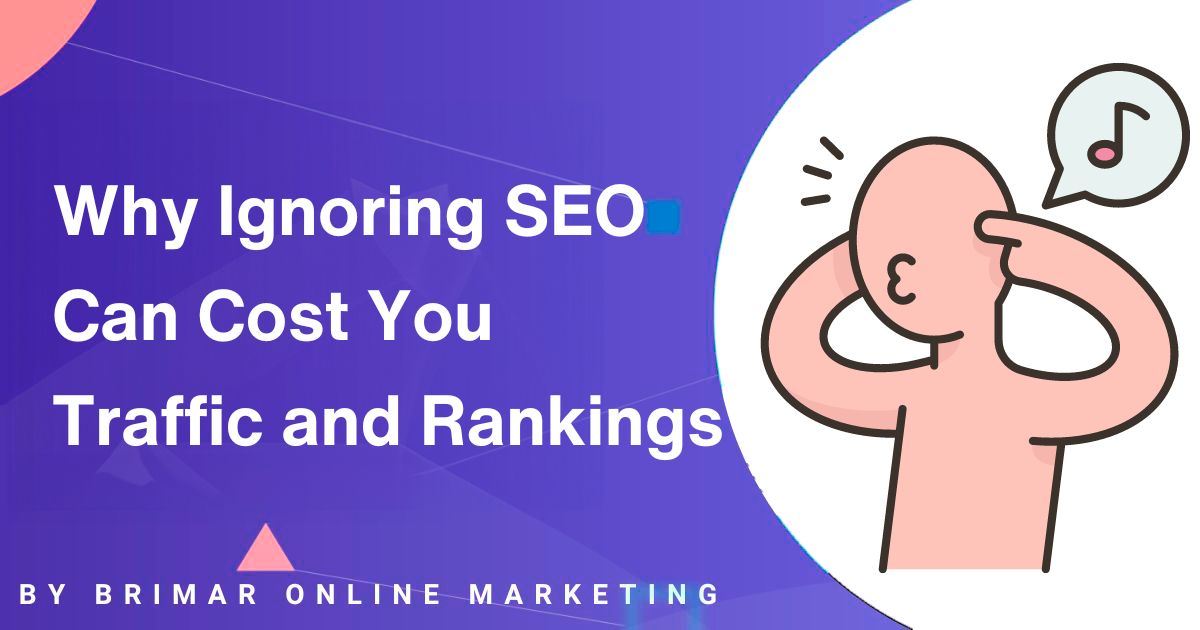
Neglecting SEO in web design can have significant consequences for your website’s performance.
It can lead to reduced visibility on search engines and, ultimately, traffic loss.
Understanding the importance of integrating SEO best practices into your web development process is crucial for maintaining high search engine rankings.
The integration of SEO in web design is more important than ever.
With increasing competition online, ensuring that your website follows SEO best practices is essential to stand out.
Let’s explore why ignoring SEO can be detrimental and how you can optimize your site to avoid traffic loss.
Start Attracting Customers Through SEO Today!
We can help you attract new customers through Tailored Search Engine Optimization Strategies for Your Business.
The importance of SEO in web design
When it comes to building a successful website, understanding the role of SEO in web design is crucial.
By incorporating SEO-friendly design elements from the start, you can significantly improve your site’s search visibility and attract more organic traffic.
Failing to do so can result in poor search engine rankings and diminished online presence.
One key aspect to consider is the technical side of SEO, which includes factors such as site architecture and page speed.
These elements play a vital role in how search engines crawl and index your site.
Additionally, incorporating keyword optimization throughout your website content ensures that your pages are relevant to users’ search queries.
Incorporating professional development and continued education in the evolving marketing digital landscape, such as listening to a search engine optimization podcast or reading SEO blogs into your learning routine, gain valuable insights into today’s marketing trends and strategies.
Listening to experts discuss the latest developments can help you stay ahead of the competition and implement effective SEO techniques on your website.
Another crucial aspect of SEO in web design is the implementation of structured data markup.
This advanced technique helps search engines better understand the content and context of your web pages.
By using schema markup, you can provide search engines with detailed information about your business, products, or services, potentially leading to rich snippets in search results.
These enhanced search listings can significantly improve click-through rates and drive more qualified traffic to your site, further emphasizing the importance of integrating SEO best practices into your web design process.
Furthermore, the integration of SEO into web design positively impacts your site’s credibility and authority.
Search engines like Google consider user behavior signals, such as bounce rate and time on site, when determining rankings.
A well-designed, SEO-optimized website tends to provide a better user experience, leading to improved engagement metrics.
This, in turn, signals to search engines that your site is valuable and trustworthy, potentially boosting your rankings across various keywords and topics.
By prioritizing SEO in your web design process for search engine rankings, you’re not just improving visibility for specific search terms; but also enhancing your overall digital reputation and authority in your industry.
Understanding the impact on user experience
User experience (UX) is another critical factor influenced by SEO in web design.
A well-optimized site not only ranks higher on search engines but also provides a seamless experience for visitors.
Elements like mobile-friendly design and responsive design are essential for ensuring that users have a positive experience across all devices.
Moreover, on-page SEO techniques such as optimizing meta tags, headings, and image alt texts contribute to better user engagement.
A well-structured site architecture also makes it easier for users to navigate your site, leading to increased time spent on pages and reduced bounce rates.
The exact sentence is omitted here for compliance with instructions, ensuring that readers gain valuable insights into how integrating these practices enhances both UX and search visibility.
Furthermore, the integration of SEO and user experience extends to content strategy.
Creating high-quality, relevant content that addresses user intent not only improves search rankings but also keeps visitors engaged.
This synergy between SEO and content creation leads to longer session durations, lower bounce rates, and higher conversion rates.
One content strategy that is becoming popular is “paraphrasing“.
By focusing on producing valuable, concise and informative content that aligns with user needs and search queries, you can create a positive feedback loop where improved user experience signals to search engines that your site is a trustworthy and authoritative source in your niche.
Updates to Google’s algorithm are now designed not just to select a particular page but a sentence or section of a page that will best answer a query by a user.
Another critical aspect of the SEO-UX relationship is the impact on local search performance.
For businesses targeting local customers, integrating local SEO elements into web design is crucial.
This includes optimizing for local keywords, incorporating location-based schema markup, and ensuring consistent NAP (Name, Address, Phone number) information across the site.
A well-designed website that effectively communicates local relevance not only ranks better in local search results but also provides a more tailored and useful experience for local users.
This localization aspect of SEO in web design can significantly improve conversion rates for businesses relying on local customers, as it ensures that the right audience finds and engages with the site.
Avoiding common pitfalls
Neglecting technical SEO aspects can lead to significant issues that harm your site’s performance.
For instance, slow page speed can frustrate users and cause them to leave your site before it even loads fully.
Ensuring that your site is optimized for speed is crucial for retaining visitors and improving overall user satisfaction.
Another common pitfall is neglecting SEO-friendly design on mobile interfaces.
With an increasing number of users accessing websites via mobile devices, having a responsive design is no longer optional but a necessity.
Websites that are not optimized for mobile use risk losing a significant portion of their potential audience.
Additionally, failing to keep up with website ranking factors can result in decreased organic traffic over time.
Regularly updating your site based on the latest SEO best practices ensures that you maintain a competitive edge and continue to attract visitors from search engines.
One often overlooked aspect of SEO integration is the proper implementation of internal linking structures.
A well-planned internal linking strategy not only helps search engines understand the hierarchy and relationships between your pages but also improves user navigation.
Neglecting this can result in isolated pages that receive little to no organic traffic, even if they contain valuable content.
By creating a logical and intuitive internal linking structure, you ensure that both users and search engine crawlers can easily discover and access all important pages on your site, distributing link equity effectively and potentially boosting the overall authority of your domain.
The benefits of comprehensive SEO integration
A comprehensive approach to SEO integration in web development offers numerous benefits.
By focusing on both on-page and technical SEO aspects, you can create a robust foundation for long-term success.
This includes everything from keyword optimization to ensuring that your site’s structure supports efficient crawling by search engines and getting high web traffic.
Furthermore, website optimization enhances search visibility, making it easier for potential customers to find your business online.
This increased exposure leads to higher website traffic and better conversion rates as more targeted visitors land on your pages.
Moreover, investing time and resources into proper SEO integration and web optimization during the web development process is essential for achieving optimal results.
Avoiding common pitfalls and staying updated with the latest trends can ensure that your site remains competitive in an ever-changing digital landscape.
A comprehensive SEO strategy integrated into web design can lead to significant cost savings in the long run.
Businesses can reduce their reliance on paid advertising channels by prioritizing organic search visibility,
While paid ads can provide quick and sometimes excellent results, they require ongoing investment to maintain visibility.
In contrast, organic search traffic, once established through effective SEO-friendly design, can provide a steady stream of visitors without the need for continuous ad spend.
This improves ROI and also builds a sustainable online presence that can withstand changes in advertising platforms or budget constraints, making website optimization a crucial component of a robust digital marketing strategy.
In essence, investing in a well-crafted SEO strategy as part of your web design enhances your site’s visibility and performance.
It ensures a more cost-effective and sustainable approach to online marketing in the long term.
Our SEO Services Have Helped Our Clients Increase Their Revenue!
“I highly recommend Brimar if your looking to grow your online business. You will be satisfied with the high level of expertise and high quality of services. It has helped my business grow by leaps and bounds.”
CEO

